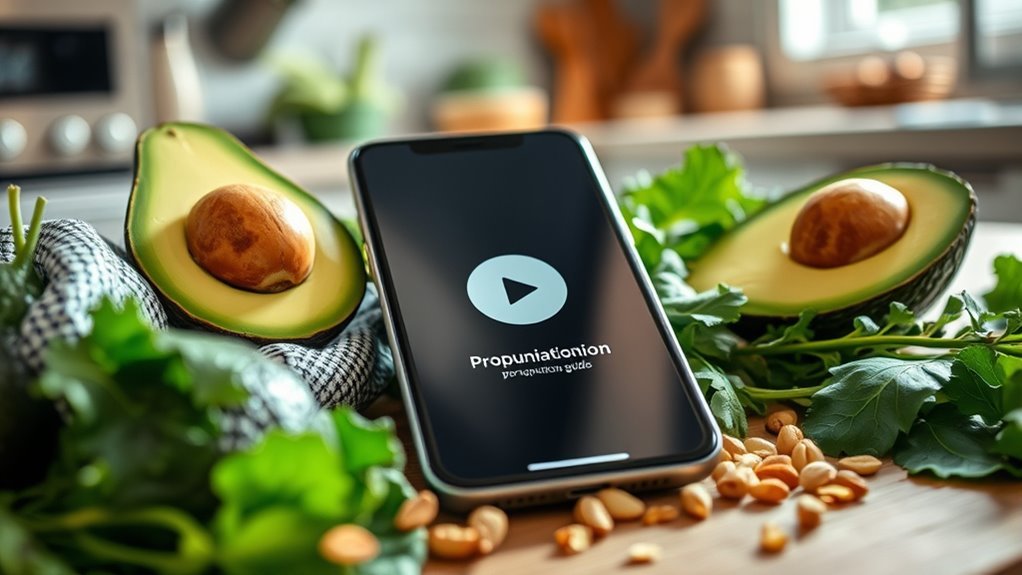To pronounce “keto” correctly, say it as “kee-toh.” Emphasize the long ‘e’ sound in the first syllable. Avoid common mispronunciations like “kee-to” or “kay-to.” Practicing slowly can help you master it. Listening to native speakers can also improve your pronunciation. By getting it right, you’ll communicate more effectively about this popular low-carb, high-fat diet. There’s plenty more to discover about keto, so stick around for additional insights and tips.
Understanding the Basics of Keto

Keto, short for ketogenic, refers to a low-carbohydrate, high-fat diet that aims to shift your body into a state of ketosis. This metabolic state encourages your body to utilize fat for energy instead of carbohydrates. Understanding keto benefits can empower you, as many people experience weight loss, improved mental clarity, and increased energy levels. However, it’s essential to navigate keto misconceptions, such as the belief that all fats are unhealthy or that the diet is unsustainable long-term. By educating yourself, you can embrace the freedom of making informed dietary choices that align with your health goals. Remember, a well-planned keto approach can be both effective and enjoyable, allowing you to thrive while managing your nutritional needs. Additionally, as you progress, monitoring ketone levels can help you gauge your body’s fat-burning effectiveness.
The Correct Pronunciation of Keto

With a solid understanding of the basics of the ketogenic diet, it’s also important to get the pronunciation right. The word “keto” is pronounced as “kee-toh.” This simple pronunciation reflects the diet’s focus on low-carbohydrate, high-fat eating, which offers various keto benefits, such as weight loss and improved energy levels. Mispronouncing it might seem trivial, but it can lead to misunderstandings about the diet and amplify keto myths. By saying “keto” correctly, you not only communicate clearly but also show respect for those who embrace this lifestyle. So, next time you discuss the ketogenic diet, remember to pronounce it “kee-toh” and confidently share those keto benefits without any confusion.
Common Mispronunciations to Avoid

When discussing the word “keto,” it’s important to recognize common mispronunciations that can occur. You might hear variations like “kee-to” or “kay-to,” which aren’t accurate. Additionally, regional differences can lead to further confusion, so let’s clarify the correct pronunciation to guarantee effective communication.
Incorrect “Keto” Variations
Many people often mispronounce “keto,” leading to confusion in conversations about this popular dietary approach. Misleading pronunciations like “kee-to” or “kay-to” can stem from cultural influences and personal assumptions. While it might seem trivial, using the correct pronunciation—”keh-toh”—ensures clarity and builds credibility when discussing keto with others. When you say “keto,” you’re not just referring to a diet; you’re connecting with a community that values accurate communication. Avoiding these mispronunciations can help you engage more effectively in discussions, whether at a dinner party or online forum. It’s essential to respect the term’s origins and pronunciation to foster understanding and promote the benefits of the keto lifestyle. So, say it right, and celebrate your food journey!
Regional Pronunciation Differences
Mispronunciations of “keto” can vary widely based on regional accents and dialects, leading to further confusion. In some areas, you might hear “kee-toe,” while others may say “keh-toh” or even “kay-to.” These variations often stem from local language influences and the way certain sounds are emphasized.
To guarantee you’re understood, it’s important to be aware of these differences. If you’re in a conversation about the keto diet, sticking to the standard pronunciation—“kee-to”—will help you communicate clearly. Avoid the common missteps tied to regional accents to foster better understanding. Embracing correct pronunciation not only enhances clarity but also promotes a more inclusive dialogue about health and wellness.
Tips for Mastering the Pronunciation
To master the pronunciation of “keto,” it’s helpful to start with a phonetic breakdown of the word. Understanding where common mispronunciations occur can also guide you in speaking it correctly. With these tips, you’ll confidently pronounce “keto” in no time.
Phonetic Breakdown
Mastering the pronunciation of “keto” can enhance your conversations about this popular diet. Understanding the phonetic symbols and sound patterns can help you articulate it correctly. Here are some tips to guide you:
- Focus on the first syllable: “kee”
- The second syllable is a soft “to”
- Emphasize the long ‘e’ sound, like in “see”
- Practice saying it slowly before speeding up
- Use online resources for audio examples
Common Mispronunciations
Despite understanding the phonetic breakdown of “keto,” many people still struggle with its pronunciation. Common mispronunciations often arise from keto misconceptions or unfamiliarity with dietary terminology. For instance, some might say “kee-to” or “kay-to,” when the correct pronunciation is “kee-toh.” To master it, focus on the short vowel sound in the first syllable and the distinct “toh” in the second. Listening to native speakers or using pronunciation apps can also help you internalize the correct sound. Don’t let these mispronunciations hold you back; embracing the right way to say “keto” can enhance your conversations about this popular dietary approach and empower your journey toward understanding it better.
The Origin of the Term “Keto”
While many people associate “keto” with modern dietary trends, the term actually has deep roots in medical history. Its origins can be traced back to the early 20th century, specifically in the treatment of epilepsy. Understanding the keto history provides insight into its dietary origins, emphasizing its therapeutic purpose rather than just a weight loss fad.
- Developed as a high-fat, low-carb diet
- Aimed to mimic the metabolic state of fasting
- Used to reduce seizure frequency in patients
- Gained popularity in the 1920s and 1930s
- Evolved into a widely adopted lifestyle choice today, with some individuals experiencing enhanced mental clarity as a result of its unique dietary approach.
Popularity and Usage in Conversations
As the keto diet has gained traction over the years, its terminology has seeped into everyday conversations, making it a common topic among health enthusiasts and casual dieters alike. You’ll find yourself engaging in keto conversations more frequently, whether at social gatherings or online forums. People share their experiences, recipes, and tips, fostering a community around these keto trends. This shift reflects a broader interest in health and wellness, encouraging individuals to explore dietary options that suit their lifestyles. As you navigate these discussions, you’ll notice how the keto diet’s popularity has transformed the way many approach nutrition. Embracing this shift can empower you to make informed choices while connecting with others on similar journeys. Many are discovering the benefits of a keto lifestyle, which include increased energy and improved mental clarity.
How Pronunciation Affects Understanding
Understanding the correct pronunciation of “keto” can greatly enhance your conversations about the diet. When you pronounce it right, it fosters better communication clarity and connection with others. Here are some ways pronunciation nuances come into play:
- Builds credibility in discussions
- Reduces confusion among listeners
- Encourages open dialogue about the diet
- Helps you share experiences and tips effectively
- Strengthens community engagement
Getting the pronunciation down isn’t just about the word itself; it’s about how you express your passion for the ketogenic lifestyle. When you articulate “keto” correctly, you invite understanding and enthusiasm, making it easier to connect with others who share your interests. So, embrace those pronunciation nuances for richer conversations!
Fun Facts About the Ketogenic Diet
Did you know that the ketogenic diet has been around for nearly a century? Initially developed to treat epilepsy, it’s gained popularity for its potential weight-loss benefits and health improvements. Many people are drawn to its ketogenic benefits, like increased energy and appetite control. However, there are plenty of keto myths that can cloud your understanding. Some believe it’s just another fad diet, but research supports its effectiveness for various health conditions. You might also hear that it’s too restrictive; in reality, it offers a wide range of delicious foods. Embracing the ketogenic lifestyle can provide you with freedom in your food choices while enhancing your overall well-being. Additionally, the diet promotes fat adaptation, allowing your body to efficiently burn fat for energy. Explore these facts to reveal the full potential of the keto journey!
Frequently Asked Questions
Is “Keto” Short for Another Term?
Yes, “keto” is short for “ketogenic,” symbolizing a path to freedom from traditional eating habits. This keto terminology roots back to the diet’s origins, designed to shift your body into a state of ketosis, where it burns fat for fuel. Embracing this diet can feel like breaking free from the chains of sugar dependency. By understanding its foundation, you empower yourself to make informed choices that align with your health goals and lifestyle.
Can “Keto” Be Pronounced Differently in Other Languages?
Yes, “keto” can be pronounced differently in various languages. While the English pronunciation typically emphasizes the first syllable, other languages might stress different parts or use distinct phonetic sounds. For example, in some languages, the “k” might be softer, and the vowel sounds can vary. Understanding these language variations can enrich your knowledge of keto pronunciation and enhance your communication with diverse audiences interested in the ketogenic lifestyle.
What Does “Keto” Stand for in Nutrition?
Keto stands for “ketogenic,” a low-carb, high-fat diet designed to encourage your body to burn fat for fuel. This approach brings several keto benefits, like weight loss and improved energy levels. However, there are common keto misconceptions, such as it being too restrictive or unhealthy. Embracing this lifestyle can offer you freedom from constant hunger, but it’s essential to educate yourself on the science behind it for ideal health and results.
Are There Variations of the Ketogenic Diet?
Yes, there are several keto variations you can explore! Some popular options include the Standard Ketogenic Diet (SKD), Targeted Ketogenic Diet (TKD), and Cyclical Ketogenic Diet (CKD). Each offers different approaches to carbohydrate intake, allowing you to tailor your ketogenic meal plans to fit your lifestyle. Whether you’re looking for flexibility or strict adherence, these variations can help you achieve your health goals while enjoying the freedom of choosing what works best for you.
How Did the Ketogenic Diet Become Popular?
The ketogenic diet skyrocketed in popularity largely due to media influence and celebrity endorsements. Imagine a spark igniting a wildfire; that’s how quickly it spread. When famous figures began sharing their keto success stories, the diet gained attention and credibility. Social media platforms amplified these narratives, making the ketogenic lifestyle seem not just effective, but desirable. As more people sought freedom from traditional diets, keto became a go-to option for many seeking change.


